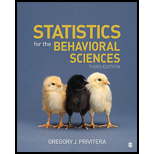
Concept explainers
1.
Identify whether the test statistic in a two independent sample t test increases, decreases, or have no effect when
1.
Answer to Problem 16CAP
The test statistic in a two independent sample t test increases when sample size is increased.
Explanation of Solution
Justification: The formula of test statistic for one-sample t test is,
In the formula,
In the formula,
The value of sample size is in the denominator of the standard error; if the sample size is increased then standard error would decrease, because standard error and sample size are inversely proportional.
Hence, the test statistic in a two independent sample t test increases when sample size is increased.
2.
Identify whether the test statistic in a two independent sample t test increases, decreases, or have no effect when level of significance is reduced from 0.05 to 0.01.
2.
Answer to Problem 16CAP
The test statistic in a two independent sample t test has no effect when level of significance is reduced from 0.05 to 0.01
Explanation of Solution
Justification: The formula of test statistic for one-sample t test is,
In the formula,
The level of significance value is not used in the calculation of the test statistic value in two independent sample t test. Whether the level of significance is increased or decreased, it does not have any effect on test statistic.
Hence, the test statistic in a two independent sample t test has no effect when level of significance is reduced from 0.05 to 0.01.
3.
Identify whether the test statistic in a two independent sample t test increases, decreases, or have no effect when pooled sample variance is doubled.
3.
Answer to Problem 16CAP
The test statistic in a two independent sample t test decreases when pooled sample variance is doubled.
Explanation of Solution
Justification: The formula of test statistic for one-sample t test is,
In the formula,
In the formula,
If the value of pooled sample variance is doubled then pooled sample standard deviation is also doubled.
The value of pooled sample standard deviation is in the numerator of the standard error, if the pooled sample standard deviation is doubled then standard error would increase, because standard error and pooled sample standard deviation are directly proportional.
The standard error value is in the denominator of test statistic value, if standard error is increased, the test statistic value decreases as standard error and test statistic are inversely proportional to each other.
Hence, the test statistic in a two independent sample t test decreases when pooled sample variance is doubled.
Want to see more full solutions like this?
Chapter 9 Solutions
Statistics for the Behavioral Sciences
 MATLAB: An Introduction with ApplicationsStatisticsISBN:9781119256830Author:Amos GilatPublisher:John Wiley & Sons Inc
MATLAB: An Introduction with ApplicationsStatisticsISBN:9781119256830Author:Amos GilatPublisher:John Wiley & Sons Inc Probability and Statistics for Engineering and th...StatisticsISBN:9781305251809Author:Jay L. DevorePublisher:Cengage Learning
Probability and Statistics for Engineering and th...StatisticsISBN:9781305251809Author:Jay L. DevorePublisher:Cengage Learning Statistics for The Behavioral Sciences (MindTap C...StatisticsISBN:9781305504912Author:Frederick J Gravetter, Larry B. WallnauPublisher:Cengage Learning
Statistics for The Behavioral Sciences (MindTap C...StatisticsISBN:9781305504912Author:Frederick J Gravetter, Larry B. WallnauPublisher:Cengage Learning Elementary Statistics: Picturing the World (7th E...StatisticsISBN:9780134683416Author:Ron Larson, Betsy FarberPublisher:PEARSON
Elementary Statistics: Picturing the World (7th E...StatisticsISBN:9780134683416Author:Ron Larson, Betsy FarberPublisher:PEARSON The Basic Practice of StatisticsStatisticsISBN:9781319042578Author:David S. Moore, William I. Notz, Michael A. FlignerPublisher:W. H. Freeman
The Basic Practice of StatisticsStatisticsISBN:9781319042578Author:David S. Moore, William I. Notz, Michael A. FlignerPublisher:W. H. Freeman Introduction to the Practice of StatisticsStatisticsISBN:9781319013387Author:David S. Moore, George P. McCabe, Bruce A. CraigPublisher:W. H. Freeman
Introduction to the Practice of StatisticsStatisticsISBN:9781319013387Author:David S. Moore, George P. McCabe, Bruce A. CraigPublisher:W. H. Freeman





